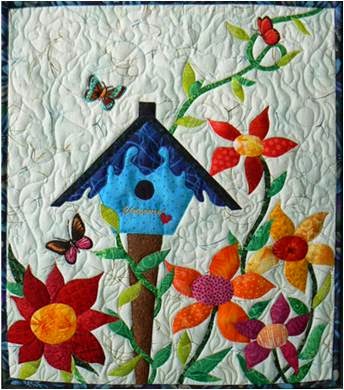It's January, and as such we are headed into Spring! SPRING! I know...there's still snow on the ground in many parts of the country, but here on Quilt Seeds we are headed for spring!
So from this day forward, I will be posting nothing but "springy" stuff as the leader on my blog. I hope it helps you point your heart toward spring as well.
I have been asked to teach a quilt class to a Ladies Group. Yay! I absolutely LOVE to share my quilting knowledge with anyone who will listen. I think I will have 8, maybe 10 ladies. So I've been working on the handouts and decided to post them on here as well.
We are in the midst of selling our home and moving, but I still have some spare time around the paperwork and the packing. I think posting this Basic Quilting Tutorial on here will be a grand first step toward my goal for the rest of the year, which is to post many, many more tutorials---for both quilting and crafting.
So, without further ado, here is the quilt tutorial. Please keep in mind there are about as many ways of going about quilting as there are people in a good sized Quilt Guild! So my methods may not be yours. That being said, I hope that all experienced quilty friends that read this will feel free to offer any suggestions or changes I should consider, as the pages have not been handed out YET and I may have missed something vital! The class is next week. So please, feel free to comment!
Basic QUILTING Tutorial
However you use the word "quilt," you should become familiar with some terms associated with the art and process so you can more easily discuss quilting issues.
The first is the top, sometimes called a “flimsy.” The top usually consists of various sizes and shapes of fabric sewn together with ¼” wide seams in a specific pattern.
The second layer is the batting. This is usually a thin sheet of cotton or poly/cotton blend filaments. It’s usually graded as “low loft,” or “high loft,” depending on how thick it is.
The third layer is called the backing. It is usually cotton fabric, color coordinated with the fabric(s) of the top.
************************************************************************************************
 Most of the time, the top of a traditional quilt is made up of
a number of BLOCKS. This red, white and blue quilt is made up of 30 blocks and some blue and red borders. You can easily discern the blocks in this quilt. However, picking out the blocks in some other quilts is a bit more difficult. Being able to define the blocks that make up a quilt will become an important skill later on!
Most of the time, the top of a traditional quilt is made up of
a number of BLOCKS. This red, white and blue quilt is made up of 30 blocks and some blue and red borders. You can easily discern the blocks in this quilt. However, picking out the blocks in some other quilts is a bit more difficult. Being able to define the blocks that make up a quilt will become an important skill later on! See if you can discern the blocks in the quilts below.
********************************************************************************************************
There are other quilts that are NOT made with a block
method. Some of these are…
.... this appliqued Hawaiian quilt with the pattern design generating from the center.........
And the magnificent shading of this watercolor wall hanging!
Compass quilts that seem to move as you admire them....
The wonderful 3 dimension of Tumbling Blocks.... There's the quick and easy rag quilt.....
The beautiful dimension and movement of Bargello.....
and art quilts that move the SOUL!
There are so many techniques and endless colors and patterns to quilts!
Each
of these quilts uses a different technique, requiring separate
classes. Because you will need to master
certain basic skills first, we will approach traditional, block-built quilts in these lessons.
So far we have learned that traditional quilts are built of blocks. This is the correct term to use for what a quilt top consists of. Many people erroneously interchange the terms “block” and “square,” which causes confusion!
*****************************************************************************************
Most Blocks are made up of a combination of squares of fabric and/or other shapes of fabric like rectangles and triangles. These are referred to as units. When you assemble these units, they become blocks.
One of the most common and most versatile units for building blocks is called the half square triangle. There are hundreds of block variations using just this humble little unit!
Another common unit for building blocks is the flying
geese unit……..
….usually sewn together in rows like this.
Other units for building blocks can include quarter square triangles.....
And square in a square!
Keep in mind that these are the basic few that most
blocks are built from, but there are many more.
So far we've covered......a
quilt consists of a three layer “sandwich:”
A top, a center
layer of batting and a backing fabric.
The top of the quilt (also
called a flimsy), usually consists of various sizes and shapes
of fabric pieces sewn together and called units.
These
units are then joined to form blocks.
The
blocks are assembled in a pattern and become the top of a traditional,
block-built quilt. There is a wide
variety of quilts that are not assembled “block-style,” as was covered previously. As you can see, the world of quilting is big and so versatile that you could spend years and years honing your skills in hundreds of techniques!
MORE TOMORROW!
*********************************************************************************************
v
v
T
T



















What a great post! It clarifies so many things that new quilters may not understand. Looking forward to your next post.
ReplyDelete